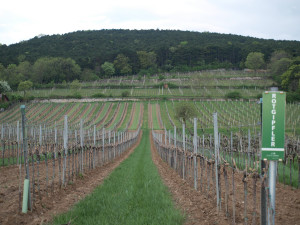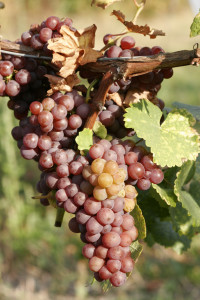The “Who’s Your Daddy” series takes a very brief look at the parentage of grapes, in order to get a better understanding of where particular varietals come from and how they are genetically related to one another. So far, we’ve covered: Cabernet Sauvignon, Carménère, Chardonnay, Gamay, Merlot, Müller-Thurgau, Muscat, Nebbiolo, Ortega, Petite Sirah, Petit Verdot, Pinotage, Pošip bijeli, Sangiovese, Syrah, Tempranillo, Torrentés riojano, Gaglioppo di Cirò, and also the grapes from the USDA grape germplasm collection. Feel free to click on any one of the varietal names to read all about their parentage.
The subject of today’s Who’s Your Daddy post is a grape that I’ve never heard of before. As you are probably well aware, there are only really a handful of grape varieties that make up the vast majority of wines that are sold in stores, whereas in reality, there are hundreds of different varieties that have been and currently are made into wines all over the globe.
As a reminder, diversity is important not only for a little variety in your life, but more importantly for the overall health and sustainability of the wine industry as a whole, particularly in this time of climate change.
Here is just one example of that diversity:

Photo by Flickr user Roberto Verzo (https://www.flickr.com/photos/verzo/8689001683/in/photolist-eePptR-9SdAfT-fePPPB)
Without further ado, the focus of this “Who’s Your Daddy?” post is the Rotgipfler grape variety (Vitis vinifera).
Brief History
I have to admit, finding information on such a rare variety is difficult, particularly when one doesn’t live anywhere near that grapes home country. I did manage to dig up a couple of interesting and useful facts anyway.
Rotgipfler is a native white Austrian grape, found in the Gumpoldskirchen district of Thermenregion in Austria (south of Vienna), though there are apparently some plantings in the Czech Republic. According to the Austrian Wine website, there are currently only 105ha (and decreasing) of Rotgipfler under cultivation, equaling about 0.2% of all wine grapes grown in the country.
The earliest recorded mention of Rotgipfler was in Styria in 1837 by one Johann Burger, only later to move to Württemberg in 1850 and later to Alsace in 1874 by one Johann Philipp Bronner.
The name “Rotgipfler” is derived from the color of the stalks and not the grapes. “Rot” in German means “red”, and red is the color found on the stalks.
Viticulture
A late-ripening grape, Rotgipfler grape clusters are medium to large with very compact berries and prefers fertile lime soils and warm hillside slopes. The tight clusters increase the grapes susceptibility to disease pressure from Botrytis cinerea, for example, and in general the Rotgipfler grape is more sensitive to frost.
As a result of its pickiness in terms of where it can grow, Rotgipfler is pretty much exclusively grown in the Thermenregion in Austria. This area is described as having a Pannonian climate, hot summers, dry autumns, and a wide variety of soil types.
Winemaking & Tasting Notes
The Rotgipfler grape is known to produce highly acidic wines, as well as wines with higher alcohol content. A wide range of wine styles can and are made from this grape, including dry, off-dry, and sweeter dessert-style wines. While nice as a varietal wine, Rotgipfler is often found blended with its brother, Zierfandler. Wines made from the Rotgipfler grape (as well as the blends) tend to produce flavors and aromas reminiscent of pear, peach, almond, and spice.
As a result of the acidity, alcohol, and overall well-balanced nature of the Rotgipfer wines, they are known to store and age well.
So, Who’s Your Daddy, Rotgipfler?
The genetic parentage should not come as a shock to any of you who know Austrian wines well, but since there probably are a lot of you reading this post that aren’t familiar with the regions native grapes and wines, you can at least say you learned one thing today.
The parents of Rotgipfler are……
Traminer…..
![Photo By Rosenzweig (Own work (own picture)) [GFDL (http://www.gnu.org/copyleft/fdl.html) or CC BY-SA 3.0 (http://creativecommons.org/licenses/by-sa/3.0)], via Wikimedia Commons](http://www.academicwino.com/wp-content/uploads/2015/05/veltliner-the-academic-wino-200x300.jpg)
Photo By Rosenzweig (Own work (own picture)) [GFDL (http://www.gnu.org/copyleft/fdl.html) or CC BY-SA 3.0 (http://creativecommons.org/licenses/by-sa/3.0)], via Wikimedia Commons
….and….
……Roter Veltliner!
There you have it! Now you are a little more familiar with the Rotgipfler grape and its genetic origins. Try and seek some out to try, if you can (and report back what you think of it!).
Do you have any experience with either Rotgipfler grapes or Rotgipfler wines? Please feel free to share your comments and/or suggestions on your favorite producer of Rotgipfler!
Further Reading:
Peer reviewed:
Online (last accessed 05/06/2015):
Austria.info – Viticulture in Lower Austria
Linkapedia Wine – Rotgipfler Wine

